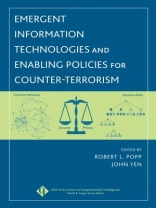Explores both counter-terrorism and enabling policy dimensions
of emerging information technologies in national security
After the September 11th attacks, ‘connecting the dots’ has
become the watchword for using information and intelligence to
protect the United States from future terrorist attacks. Advanced
and emerging information technologies offer key assets in
confronting a secretive, asymmetric, and networked enemy. Yet, in a
free and open society, policies must ensure that these powerful
technologies are used responsibly, and that privacy and civil
liberties remain protected.
Emergent Information Technologies and Enabling Policies for
Counter-Terrorism provides a unique, integrated treatment of
cutting-edge counter-terrorism technologies and their corresponding
policy options. Featuring contributions from nationally recognized
authorities and experts, this book brings together a diverse
knowledge base for those charged with protecting our nation from
terrorist attacks while preserving our civil liberties.
Topics covered include:
* Counter-terrorism modeling
* Quantitative and computational social science
* Signal processing and information management techniques
* Semantic Web and knowledge management technologies
* Information and intelligence sharing technologies
* Text/data processing and language translation technologies
* Social network analysis
* Legal standards for data mining
* Potential structures for enabling policies
* Technical system design to support policy
Countering terrorism in today’s world requires innovative
technologies and corresponding creative policies; the two cannot be
practically and realistically addressed separately. Emergent
Information Technologies and Enabling Policies for
Counter-Terrorism offers a comprehensive examination of both areas,
serving as an essential resource for students, practitioners,
researchers, developers, and decision-makers.
Inhoudsopgave
Foreword.
Preface.
Contributors.
Chapter 1: Utilizing Information and Social Science Technology
to Understand and Counter the Twenty-First Century Strategic Threat
1 (Robert L. Popp, David Allen, and Claudio
Cioffi-Revilla).
Chapter 2: Hidden Markov Models and Bayesian Networks for
Counter-Terrorism (Krishna Pattipati, Peter Willett, Jeffrey
Allanach, Haiying Tu, and Satnam Singh).
Chapter 3: Anticipatory Models for Counter-Terrorism (Mark
Lazaroff and David Snowden).
Chapter 4: Information Processing at Very High Speed Data
Ingestion Rates (J. Brian Sharkey, Doyle Weishar, John W.
Lockwood, Ron Loui, Richard Rohwer, John Byrnes, Krishna Pattipati,
Stephen Eick, David Cousins, and Michael Nicoletti).
Chapter 5: Analysis of Heterogeneous Data in Ultrahigh
Dimensions (R. A. Ammar, S. A. Demurjian , Sr., I. R.
Greenshields, Krishna Pattipati, and S. Rajasekaran).
Chapter 6: Semantic Web Technologies for Terrorist Network
Analysis (Jennifer Golbeck, Aaron Mannes, and James
Hendler).
Chapter 7: Improving National and Homeland Security Through
Context Knowledge Representation and Reasoning Technologies
(Nazli Choucri, Stuart E. Madnick, and Michael D.
Siegel).
Chapter 8: Anonymized Semantic Directories and a
Privacy-Enhancing Architecture for Enterprise Discovery (Jeff
Jonas and John Karat).
Chapter 9: Facilitating Information Sharing Across Intelligence
Community Boundaries Using Knowledge Management and Semantic Web
Technologies (Brian Kettler, Gary Edwards, and Mark
Hoffman).
Chapter 10: Applying Semantic Web Reasoning to Counter-Terrorism
(Paul Kogut, Yui Leung, Kathleen M. Ryan, Linda Gohari,
Mieczyslaw M. Kotar, and Jerzy J. Letkowski).
Chapter 11: Schemer: Consensus-Based Knowledge Validation and
Collaboration Services for Virtual Teams of Intelligence Experts
(Clifford Behrens, Hyong-Sop Shim, and Devaisis Bassu).
Chapter 12: Sharing Intelligence Using Information Supply Chains
(Shuang Sun, Xiaocong Fan, and John Yen).
Chapter 13: Supporting Knowledge Management In Emergency Crisis
Management Domains: Envisioned Designs for Collaborative Work
(Michael D. Mc Neese, Isaac Brewer, Rashaad E. T. Jones, and Erik
S. Connors).
Chapter 14: Agent-Based Simulations for Disaster Rescue Using
the DEFACTO Coordination System (Janusz Marecki, Nathan Schurr,
and Milind Tambe).
Chapter 15: Transcending the Tower of Babel: Supporting Access
to Multilingual Information with Cross-Language Information
Retrieval (Douglas W. Oard).
Chapter 16: Journey from Analysis to Inquiry: Technology and
Transformation of Counter-Terrorism Analysis (Aaron B. Frank and
Desmond Saunders-Newton).
Chapter 17: Behavioral Network Analysis for Terrorist Detection
(Seth A. Greenblatt, Thayne Coffman, and Sherry E.
Marcus).
Chapter 18: Detecting Terrorist Activities in the Twenty-First
Century: A Theory of Detection for Transactional Networks (Tom
Mifflin, Chris Boner, Greg Godfrey, and Michael
Greenblatt).
Chapter 19: Social Network Analysis Via Matrix Decompositions
(D. B. Skillicorn).
Chapter 20: Legal Standards for Data Mining (Fred H.
Cate).
Chapter 21: Privacy and Consequences: Legal and Policy
Structures for Implementing New Counter-Terrorism Technologies and
Protecting Civil Liberty (Paul Rosenzweig).
Chapter 22: Designing Technical Systems to Support Policy:
Enterprise Architecture, Policy Appliances, and Civil Liberties
(K. A. Taipale).
Index.
About the Editors.
Over de auteur
ROBERT L. POPP, Ph D, is currently an Executive Vice
President of Aptima, Inc., and formerly a senior executive within
the Defense Department, serving in the Office of the Secretary of
Defense and Defense Advanced Research Projects Agency (DARPA). He
is an expert in national security and counter-terrorism, authoring
numerous scientific papers and providing many technical briefings
and interviews on the subject. He is a member of the Defense
Science Board (DSB), Senior Associate for the Center for Strategic
and International Studies (CSIS), Senior Member of the IEEE, member
of ACM and AAAS, founding Fellow of the University of Connecticut
Academy of Distinguished Engineers, and a lifetime member of HOG
(the Harley Owners Group).
JOHN YEN, Ph D, is currently University Professor of
Information Sciences and Technology and Professor in Charge,
College of Information Sciences and Technology at The Pennsylvania
State University. He is the author of numerous papers, holds one
patent, chairs IEEE FIPA standard working groups on human agent
communications, and is a member and Fellow of IEEE.












